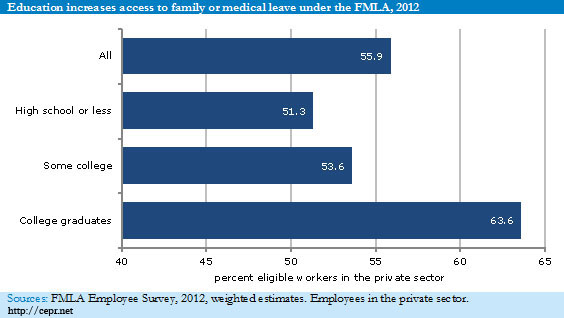
Over 20 years ago Congress passed the Family and Medical Leave Act, and President Bill Clinton signed it into law two weeks after his inauguration in 1993. Remember the optimism? Under the FMLA a qualified employee can take up to 12 weeks of unpaid leave to care for a sick family member or for pregnancy, newborn, newly adopted, or for care of a new foster child. In a good-news bad-news sense, one of the notable features of the FMLA was that it was gender-neutral: men and women equally had no funding for their job-protected leave for up to 12 weeks per year. Otherwise, this policy for helping families has been the weakest compared to other rich countries. At the time, the FMLA was the “foot in the door” for improving the situation of working families. A hint for how FMLA is doing today was offered by Girlwpen’s Susan Bailey earlier this week.
So…how’s that foot in the door now? Several recent studies offer new tools for analysis. In “Expanding Federal Family and Medical Leave Coverage,” economists Helene Jorgenson and Eileen Appelbaum investigated who benefits from FMLA using the 2012 FMLA Employee Survey conducted by the Department of Labor. About one in five qualified employees has used FMLA leave within the past 18 months, according to a new Center for Economic and Policy Research (CEPR) report. The authors found an extensive amount of unmet need for family and medical leave.
Several key limitations of the FMLA mean that, in practice, the law doesn’t apply to a large share of the workforce. The FMLA does not cover workers in firms with fewer than 50 employees. As a result, 44.1 percent of workers in the private sector (49.3 million workers) are excluded from protected leave for caring for their sick or vulnerable relations. The FMLA also excludes employees who have been at their current job for less than a year or have worked fewer than 1250 hours in the past year.
Not everyone with needy kin works in mid-to-large size firms nor has regular employment. So, those limits on access to FMLA do not affect everyone equally. Young workers and Hispanic workers had lower rates of eligibility than other groups. Education level was the strongest predictor of eligibility. People with less than a high school degree were 13.6 percentage points less likely than those with “some college” to have access to unpaid leave for family and medical concerns. Meanwhile, those with a college degree were 10.7 percentage points more likely than those with some college to have access to FMLA leave.

Have there been improvements in the past two decades? Another recent study from CEPR and the Center for American Progress, “Job Protection isn’t Enough: Why America Needs Paid Parental Leave,” by Heather Boushey, Jane Farrell, and John Schmitt, points to no. Analysis of data from the Current Population Survey over the past 20 years revealed two key things: First, women take leave way more than men despite the gender neutrality of the policy. Men have increased from a very low rate, but the ratio in the last five years studied is about nine to one. In addition, over the past two decades there has been essentially no change in women’s rates of leave-taking.
Also, per Boushey and colleagues, guess who is most likely to benefit from leave? Women with college degrees and those in full-time jobs. Commenting on their statistical analysis, the authors state, “Better-educated, full-time, union women are more likely than their otherwise identical counterparts to take parental leave” (p. 12). Not everyone can be in a job that qualifies them for FMLA leave; however once qualified, not everyone has the financial security to use that leave.
These authors—like Jorgenson and Appelbaum—applaud the FMLA and the opportunities it has provided to qualified workers—but their data show that the 1993 Act did not generate a cascade of family-progressive policies for men, women, and families. But one can hope. Jorgenson and Appelbaum demonstrate that a policy that reduced the firm size from 50 to 30 and reduced the hours worked in the past year from 1250 to 750, an additional 8.3 million private sector workers would be eligible for family leave under FMLA.
There are some pretty great examples of places in the United States where better family leave policies have been put in place and have worked well. California passed a paid family leave act in 2002, and after twelve years, the program has been highly successful. Appelbaum and Ruth Milkman reported in 2011 about the social, family, and economic benefits of the program. Washington State passed similar legislation in 2007 but it has been help up since then. New Jersey did so in 2008, and Rhode Island’s law was implemented in January 2014. Another review of the California paid leave program demonstrates the growth in uptake since its initiation, but reports that uptake continues to be low because while the leave is paid one’s job is not protected.
We just celebrated 50 years of the Civil Rights Act. Last year we celebrated 50 years since the Equal Pay Act. Retrospectives on such landmark legislation includes successes as well as persisting shortfalls. We are at 21 and counting with FMLA. These studies remind us that with FMLA we need to do more to have more success than shortfalls.


Comments